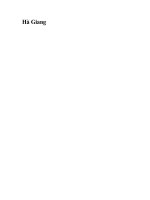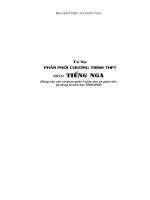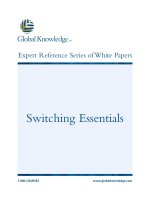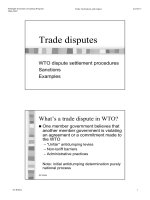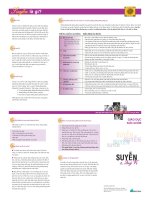Tài liệu Gears P2 pptx
Bạn đang xem bản rút gọn của tài liệu. Xem và tải ngay bản đầy đủ của tài liệu tại đây (519.22 KB, 20 trang )
When the center distance is increased by a relatively small amount,
∆
C, a backlash space develops
between mating teeth, as in Figure 1.21. The relationship between center distance increase and linear
backlash, B
LA
, along the line of action, is:
B
LA
= 2(
∆
C)sin
φ
(21)
This measure along the line-of-action is useful when inserting a feeler gage between teeth to measure backlash.
The equivalent linear backlash measured along the pitch circle is given by:
B = 2(
∆
C) tan
φ
(22a)
where:
∆
C = change in center distance
φ
= pressure angle
Hence, an approximate relationship between center distance change and change in backlash is:
∆
C= 1.933
∆
B for 14½° pressure-angle gears (22b)
∆
C= 1.374
∆
B for 20° pressure-angle gears (22c)
T47
Although these are approximate relationships they are adequate for most uses. Their derivation, limitations, and correction
factors are detailed in Reference 5.
Note that backlash due to center distance opening is dependent upon the tangent function of the pressure angle. Thus, 20°
gears have 41% more backlash than 14½º gears, and this constitutes one of the few advantages of the lower pressure angle.
Equations 22 are a useful relationship, particularly for converting to angular backlash. Also for fine-pitch gears the use of
feeler gages for measurement is impractical, whereas an indicator at the pitch line gives a direct measure. The two linear
backlashes are related by:
B
LA
(23)
B =
_____
cos φ
The angular backlash at the gear shaft is usually the critical factor in the gear application. As seen
from Figure 1.20a this is related to the gear’s pitch radius as follows:
B (24)
a
B = 3440
____
(arc minutes)
R
1
Obviously, angular backlash is inversely proportional to gear radius. Also, since the two meshing gears are usually of
different pitch diameters, the linear backlash of the measure converts to different angular values for each gear. Thus, an angular
backlash must be specified with reference to a particular shaft or gear center.
4.11 Summary of Gear Mesh Fundamentals
The basic geometric relationships of gears and meshed pairs given in the above sections are summarized in Table 1.7.
T48
TABLE 1.7 SUMMARY OF FUNDAMENTALS
SPUR GEARS
To Obtain From Known Symbol and Formula
Pitch diameter Number of teeth and pitch
D = N = N·P
c
P
d
π
Circular Pitch
Diametral pitch or number of
teeth and pitch diameter
P
c
= π = π D
P
d
N
Diametral pitch
Circular pitch or number of
teeth and pitch diameter
P
d
= π = N
P
c
D
Number of teeth Pitch and pitch diameter
N =DP
d
= D
P
c
Outside diameter
Pitch and pitch diameter or
pitch and number of teeth
D
o
=D + 2 = N+2
P
d
P
d
Root diameter Pitch diameter and dedendum
D
R
= D - 2b
Base circle diameter Pitch diameter and pressure angle
D
b
=D cos φ
Base pitch Circular pitch and pressure angle
P
b
= P
c
cos φ
Tooth thickness at
standard pitch diameter
Circular pitch
T
std
= P
c
= πD
2 2N
Addendum Diametral pitch
a = 1
P
d
Center distance
Pitch diameters Or number
of teeth and pitch
C=D
1
+D
2
=N
1
+N
2
=P
c
(N1+N2)
2 2P
d
2π
Contact ratio
Outside radii, base radii, center
distance and pressure angle
mp = (R
o
²-R
b
²)
½
+(r
o
²-r
b
²)
½
-C sin φ
P
c
cos φ
Backlash (linear) From change in center distance
B = 2 (∆C) tan φ
Backlash (linear) From change in tooth thickness
B = ∆T
Backlash (linear)
along line of acvon
Linear backlash along pitch cirde
B
LA
= B cos φ
Backlash, angular Linear backlash
a
B = 6880 B (arc minutes)
D
Minimum number of
teeth for no undercutting
Pressure angle
N = 2
sin² φ
Dedendum
Pitch diameter and
root diameter ( D
R
)
b = ½(D-D
R
)
Clearance Addendum and dedendum c = b - a
Working depth Addendum
h
k
= 2a
Pressure angle
( standard )
Base circle diameter and pitch
diameter
φ =cos
-1
D
b
/D
Operating pressure
angle
Actual operating pitch diameter
and base circle diameter
φ =cos
-1
D
b
/D'
T49
TABLE 1.7 CONT. - SUMMARY OF FUNDAMENTALS
HELICAL GEARING
To Obtain From Known Symbol and Formula
Normal circular pitch Transverse circular pitch
P
cn
= P
c
cos ψ
Normal diametral pitch Transverse diametral pitch
P
dn
= P
d
cos ψ
Axial pitch Circular pitches
P
a
= P
c
cot ψ = P
cn
sin ψ
Normal pressure angle Transverse pressure angle
tan φ
n
= tan φ cos ψ
Pitch diameter Number of teeth and pitch
D = N = N
P
d
P
dn
cos ψ
Center distance
(parallel shafts)
Number of teeth and pitch
C = N
1
+ N
2
2 P
dn
cos ψ
Center distance
(crossed shafts)
Number of teeth and pitch
C = 1 ( N
1
+ N
2
)
2 P
dn
cos ψ
1
cos ψ
2
Shaft angle
(Crssed shafts)
Helix angles of 2 mated gears
θ = ψ
1
+ ψ
2
Addendum
Pitch; or outside and pitch
diameters
a = 0.5 ( D
o
- D ) = 1
P
d
Dedendum
Pitch diameter and root
diameter (D
R
)
b = 0.5 ( D - D
R
)
Clearance Addendum and dedendum c = b-a
Working depth Addendum
h
k
= 2a
Transverse pressure
angle
Base circle diameter and
pitch circle diameter
cos φ
t
= D
b
/ D
Pitch helix angle
Number of teeth,
normal diametral pitch and
pitch diameter
cos ψ = N
P
n
D
Lead
Pitch diameter and
pitch helix angle
L = π D cos ψ
INVOLUTE GEAR PAIRS
To Obtain Symbols
Spur or Helical Gears ( g gear; p = pinion)
Length of action
Z
A
Z
A
= (C² - (R
b
+r
b
)²)
½
(maximum)
Z
A
= (R
o
²-R
b
²)
½
(r
o
²-r
b
²-C sin φ
r
)
½
Start of active profile SAP
SAP
p
= -(R
o
²-R
b
²)
½
SAP
g
= Zmax-(r
o
²-r
b
²)
½
Contact ratio
R
c
Rcg = ((SAP)² + Rb²)
½
; R
cp
= ((SAP)² + r
b
²)
½
T50
TABLE 1.7 CONT. - SUMMARY OF FUNDAMENTALS
WORM MESHES
To Obtain From Known Symbol and Formula
Pitch diameter of worm Number of teeth and pitch
d
w
= n
w
P
cn
p sin λ
Pitch diameter of
worm gear
Number of teeth and pitch
D
g
= N
g
P
cn
π cos λ
Lead angle Pitch, diameter, teeth
λ = tan
-1
n
w
= sin
-1
n
w
P
cn
P
d
d
w
pd
w
Lead of worm Number of teeth and pitch
L = n
w
p
c
= n
w
p
cn
cos λ
Normal circular pitch Transverse pitch and lead angle
P
cn
= P
c
cos λ
Center distance Pitch diameters
C = d
w
+ D
g
2
Center distance Pitch, lead angle, teeth
C = P
cn
[ N
g
+ n
w
]
2π cos λ sin λ
Velocity ratio Number of teeth
Z = Ng
n
w
BEVEL GEARING
To Obtain From Known Symbol and Formula
Velocity ratio Number of teeth
Z = N
1
N
2
Velocity ratio Pitch diameters
Z = D
1
D
2
Velocity ratio Pitch angles
Z = sin γ
1
sin γ
2
Shaft angle Pitch angles
Σ = γ
1
+ γ
2
T51
5.0 HELICAL GEARS
The helical gear differs from the spur gear in that its teeth are twisted along a helical path in the axial direction. It resembles the
spur gear in the plane of rotation, but in the axial direction it is as if there were a series of staggered spur gears. See Figure 1.22.
This design brings forth a number of different features relative to the spur gear, two of the most important being as follows:
1. tooth strength is improved because of the elongated helical wrap around
tooth base support.
2. contact ratio is increased due to the axial tooth overlap. Helical gears thus
tend to have greater load-carrying capactiy than spur gears of the same size.
Spur gears, on the other hand, have a somewhat higher efficiency.
Helical gears are used in two forms:
1. Parallel shaft applications, which is the largest usage.
2. Crossed-helicals (or spiral gears) for connecting skew shafts, usually at tight
angles.
5.1 Generation of the Helical Tooth
The helical tooth form is involute in the plane of rotation and can be developed in a manner similar to that of the spur gear.
However, unlike the spur gear which can be viewed essentially as two dimensional, the helical gear must be portrayed in three
dimensions to show changing axial features.
Referring to Figure 1.23, there is a base cylinder from which a taut plane is unwrapped, analogous to the unwinding taut
string of the spur gear in Figure 12. On the plane there is a straight line AB, which when wrapped on the base cylinder has a
helical trace A
o
B
o
. As the taut plane is unwrapped any point on the line AB can be visualized as tracing an involute from the base
cylinder. Thus, there is an infinite series of involutes generated by line AB, all alike, but displaced in phase along a helix on the
base cylinder.
Again a concept analogous to the spur-gear tooth development is to imagine the taut plane being wound from one base
cylinder on to another as the base cylinders rotate in opposite directions. The result is the generation of a pair of conjugate
helical involutes. If a reverse direction of rotation is assumed and a second tangent plane is arranged so that it crosses the first, a
complete involute helicoid tooth is formed.
T52
5.2 Fundamental of Helical Teeth
In tho piano of rotation the helical gear tooth is involute and all of the relationships govorning spur gears apply to the helical.
However, tho axial twist of the teeth introduces a holix anglo. Since the helix angle varies from the base of the tooth to the
outside radnjs, the helix angle, w~ is detned as the angle between the tangent to the helicoidal tooth at the intersection of the
pitch cylinder and the tooth profile, and an element of the pitch cylinder. See Figure 1.24.
The direction of the helical twist is designated as either left or right. The direction is defined by the right-hand rule.
5.3 Helical Gear Relationships
For helical gears there are two related pitches: one in the plane of rotation and the other in a plane normal to the tooth. In
addition there is an axial pitch. These are defined and related as follows: Referring to Figure 1.25, the two circular pitches are
related as follows:
P
cn
= P
c
cos ψ = normal circular pitch (25)
The normal circular pitch is less than the transverse or circular pitch in the plane of rotation, the ratio between the two being
equal to the cosine of the helix angle. Consistent with this, the normal diametral pitch is greater than the transverse pitch:
P
dn
= P
d
= normal diametral pitch (26)
cos ψ
The axial pitch of a helical gear is the distance between corresponding points of adjacent teeth measured parallel to the
gears axis—see Figure 1.26. Axial pitch, p1. is related to circular pitch by the expressions:
P
a
= P
c
cot ψ = P
cn
= axial pitch (27)
sin ψ
T53
5.4 Equivalent Spur Gear
The true involute pitch and involute geometry of a helical gear is that in the plane of rotation. However, in the normal plane, looking
at one tooth, there is a resemblance to an involute tooth of a pitch corresponding to the normal pitch. However, the shape of the
tooth corresponds to a spur gear of a larger number of teeth, the exact value depending on the magnitude of the helix angle.
The geometric basis of deriving the number of teeth in this equivalent tooth
form spur gear is given in Figure 1.27. The result of the transposed geometry
is an equivalent number of teeth given as:
N
V
= N (28)
cos³ψ
This equivalent number is also called a virtual number because this spur
gear is imaginary. The value of this number is its use in determining helical
tooth strength.
5.5 Pressure Angle
Although strictly speaking, pressure angle exists only for a gear pair, a nominal pressure angle can be considered for an individual
gear. For the helical gear there is a normal pressure angle as well as the usual pressure angle in the plane of rotation. Figure 1.28
shows their relationship, which is expressed as:
tan φ = tan φ
n
(29)
cos ψ
5.6 Importance of Normal Plane Geometry
Because of the nature of tooth generation with a rack-type hob, a single tool can generate helical gears at all helix angles as well as
spur gears. However, this means the normal pitch is the common denominator, and usually is taken as a standard value. Since the
true involute features are in the transverse plane, they will differ from the standard normal values. Hence, there is a real need for
relating parameters in the two reference planes.
T54
f

